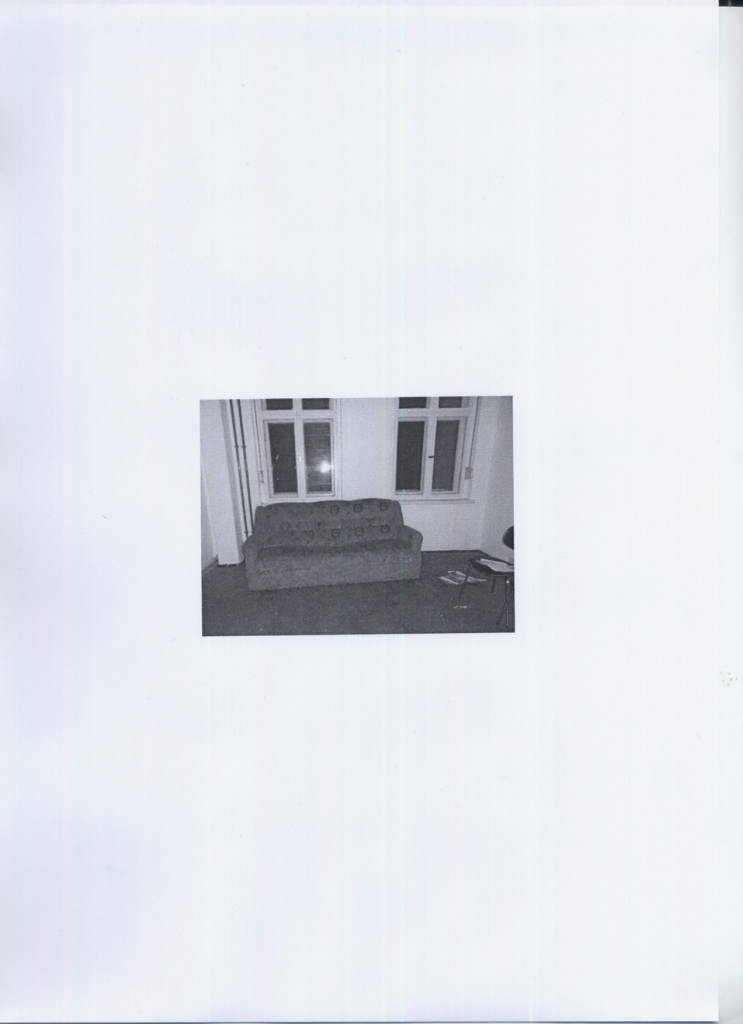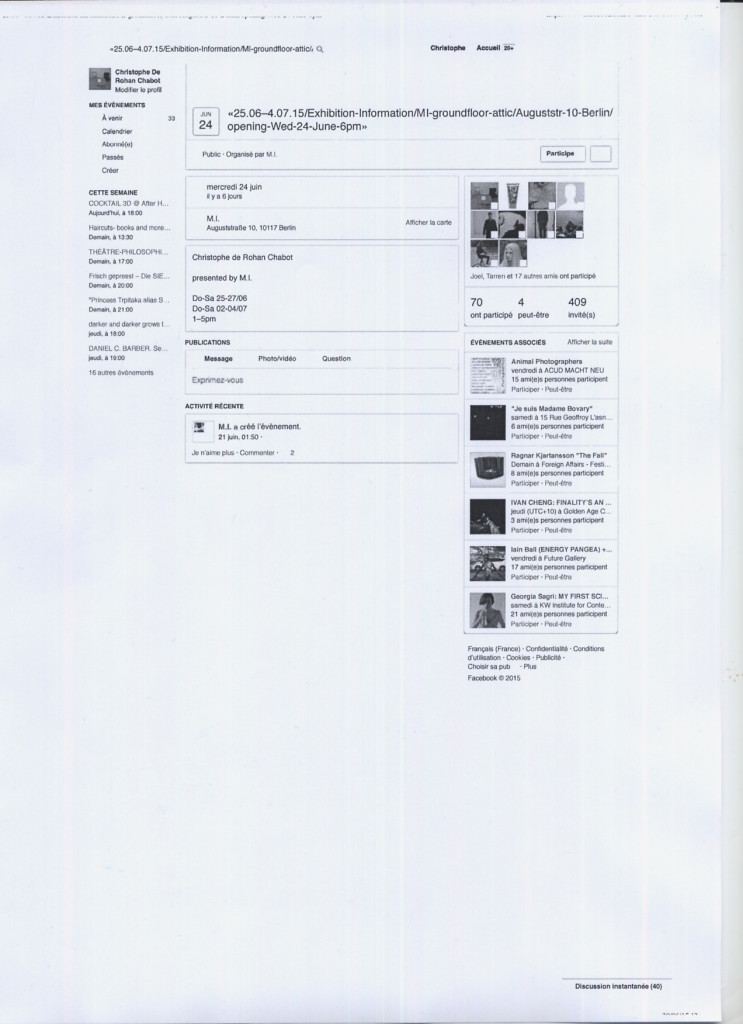M.I, a temporary gallery space initiated by curator and art history researcher Joel Mu, opened to the public with solo show, «25.06–4.07.15/Exhibition-Information/MI-groundfloor-attic/Auguststr-10-Berlin/opening-Wed-24-June-6pm», by Christophe de Rohan Chabot on June 24. The gallery, which will be open two weeks at the end of each month, has residence on the ground floor shopfront of collective house and theatre project Kunsthaus KuLe, with a satellite space in the building’s attic.
From one end of the building to the other the space absorbs the physical interruption of a stairwell, a passageway marked with the lives of its tenants, past and present. In addition to this spatial split, the gallery must also reckon with inconstant temporality, due to a timeshare arrangement with the house’s various other projects. Its online presence, limited to a Facebook page is intentionally scant. All the information available on the event page is deferred to its title, a notably wordy string of text that is formatted like a backend directory listing, as if it were meant to be read by a computer. It is evocative of ethereal processes, the hundreds of invisible automated communications made in the background of our online manoeuvrings, or the nanoscopic transformations inside each energetic shift. Inside the space, the objects of this exhibition are a series of documentations, scattered hefts of printed A4 pages, Its affect / effect is experiential. An apparent collaboration between artist and curator, M.I’s inaugural show offers an intelligent and elegant take on reconfiguring space and establishing a presence on what is one of the most institutionally entrenched and commercially established gallery strips in Berlin.

Entering through the back door, the exhibition room is unassuming, the installation minimal. Chairs are lined up along two opposing walls, white printouts collect on seats; stapled bundles, loose piles, single pages. Visitors flip through fastened sheets, or sit balancing a wad of loose pages on their laps. In the fattest pile, a few words printed on the bottom right corner of every other page, ‘entrance’, ‘chair’, ‘door’, ‘couch’, ‘advertisement’. On alternate pages there are small images, an ornate foyer, a front door, a poster on a toilet door. The words and pictures are both generic and increasingly familiar. Another heft depicts a floor plan, walls, windows, doors, a couch, marking dimensions, obstacles, entrances and exits. Yet another is a chat between artist and curator. A back and forth about the show, the title, design of a poster for the door, who should host the FB event.
A meta gesture, the pages – materialised in the space – depict the physicalities of the building like a reverse hypostatisation, situating, somewhere between the documentation of the space and its physical presence, a proxy. Like a trompe l’oeil, it writes the space into the imagination of those viewing the work.
The challenge of opening any space has to do with how it gets filled, as important as the art objects being shown are the energies, old and new, that take up residence. Cleared and freshly painted, a room becomes a gallery, is elevated to a spiritual plain. Even when emptied and white, a pristine space can be haunted by its past. A few forgotten tiles point to where a kitchen sink had been, an intentional reference in the name, or a disparity between patrons and local residents made apparent on opening nights. They hang about as traces, as ghosts, as indicators of the space’s positioning within structural paradigms.

Chabot’s installation is a kind of incantation. It works as a spell, perhaps an exorcism, as if Chabot were not so much showing his work but providing a service. In post event digital times, art shows can happen on an informational level without having to take physical space. From virtual exhibition platforms to the fact that most art is circulated as installation documentation. Chabot offers up this informational aspect as a proxy, as a kind of voodoo doll. By allowing this proxy to become precarious, the space is reconfigured.
As people handle the works, pages get separated, some drop to the floor or are scattered across surfaces. It is not clear where they belong, if they are in order, if there is an order. As they start to show the marks of wear and use – as this informational portrait falls apart – their original precarity becomes true. Like a shedding plant, Chabot’s virtual representation collapses but is still supported by the space that it was meant to represent. The leaves drop but they are kept, collected by the room.
On another level, the exhibition also addresses anxieties connected to data regimes. There is a kind of mythology or fear connected to digital information, that while our bodies will rot and buildings will fall, data because of its immaterial state will last forever. By exposing the show’s informational portrait as precarious, it also serves as a relief, as a kind of spell against this fear.
Between the poetics of default settings of printing technologies and the corruption or interruption of its depiction, the room is freed of its virtual representation and hence is divorced from its former uses, the remaining questions of which being tied to this representation. This moment is a generous one in which the room, the exhibition space, M.I., is allowed to become itself. **
Christophe de Rohan Chabot’s «25.06–4.07.15/Exhibition-Information/MI-groundfloor-attic/Auguststr-10-Berlin/opening-Wed-24-June-6pm» exhibition ran at Kunsthaus KuLe from June 25 to July 6, 2015.
Header image: Christophe de Rohan Chabot, ‘scan (A4 digital print, poster)’ 2015. Courtesy the artist and M.I/mi1glissé, Berlin.













